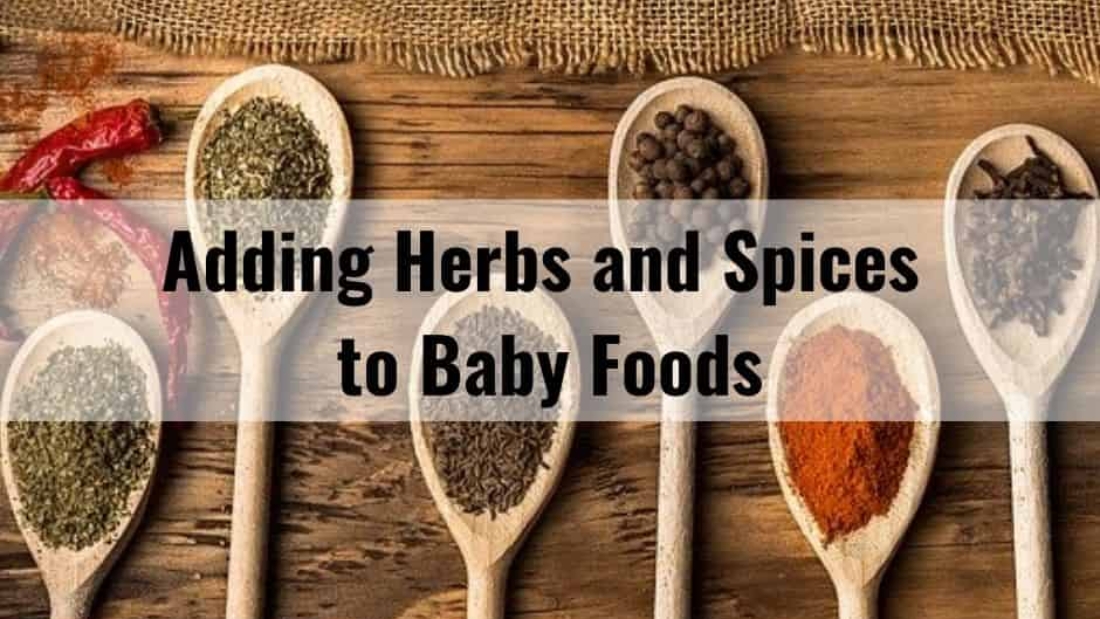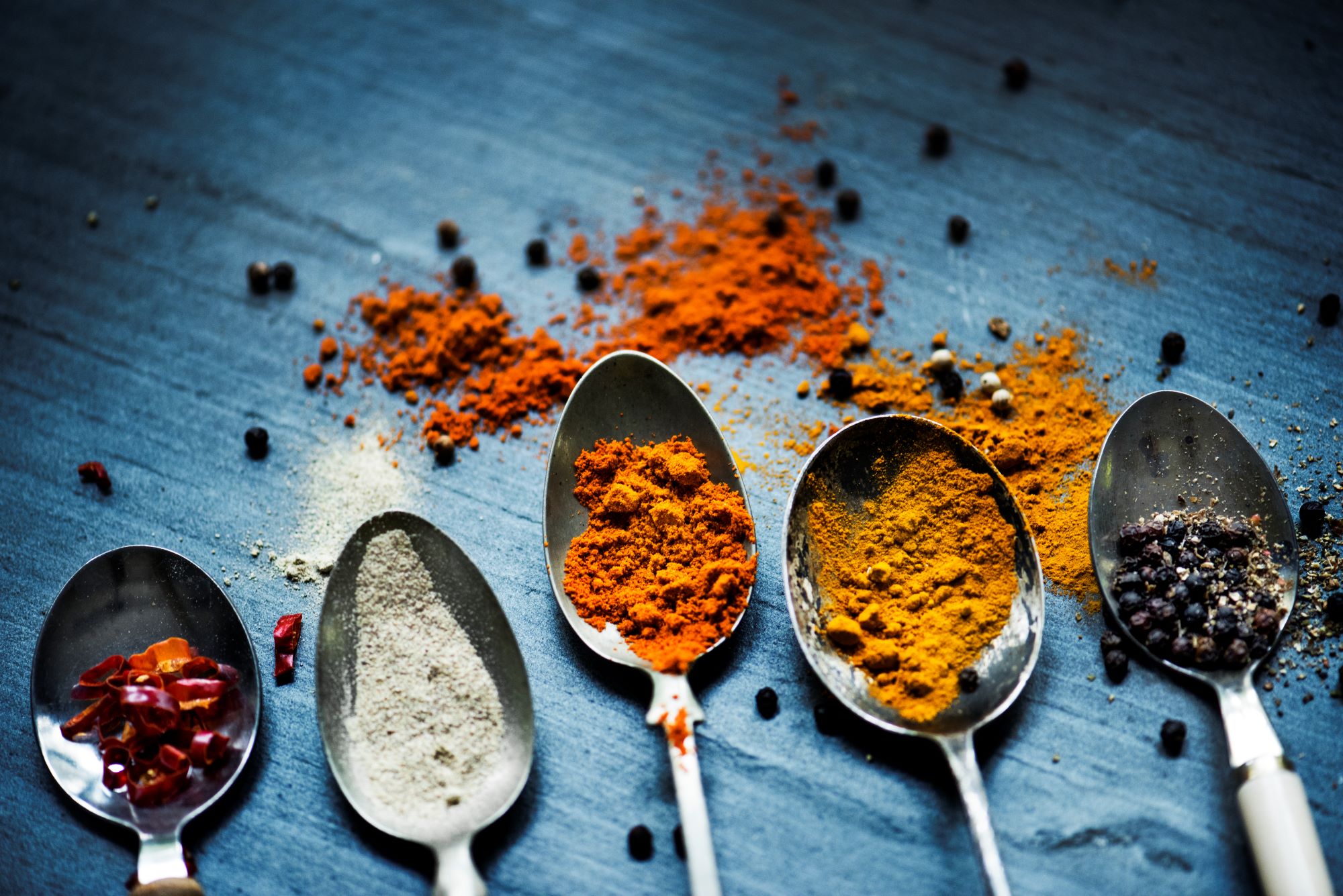Herbs and spices provide our foods with a multitude of flavours, fragrances, and colours. However, many parents worry about adding flavour this way to their babies’ food, believing that spices are hot and not suitable for little ones’ taste buds.
Baby food doesn’t have to be bland!
There is a big difference between hot spices and aromatic ones. Aromatic spices, such as turmeric, garlic, ginger, dill, cumin, nutmeg, garlic, dill, and cinnamon, are perfectly fine to introduce to baby after 6 months.
This guide explains why I recommend parents adding herbs and spices to baby’s food, the benefits of adding them and gives some ideas on how to start introducing them to your baby.
WHY YOU SHOULD INTRODUCE HERBS AND SPICES TO BABIES
If your baby doesn’t have any digestive problems, I always encourage parents who are just starting weaning their babies, either by purees or baby led weaning (around 6 months of age), to experiment with herbs and spices from the beginning. The more you expose your baby to a variety of tastes and flavours, between 6-12 months, the more likely it is that they’ll accept a variety of food later on in life! This means adding herbs and spices right from the beginning helps reduce the chances of pickiness.
In fact, breastfed babies are often introduced to a variety of spices even before starting solids. Breast milk can change its flavour, depending on a mum’s diet. If mum enjoys spicy and flavoursome food, then her baby will be exposed to this through her milk, helping create and develop a taste for flavoured foods. Therefore, by flavouring food with a variety of herbs and spices, you’ll continue the benefits of flavour exposure found in breastmilk.
What about exclusively formula fed babies? We know that babies are made to handle various flavours from the first day of their life, they were capable of experiencing various spices without any issues. So bland food is actually not a requirement for them and it’s natural for them to experience different flavours. If your baby is exclusively formula fed, then they wouldn’t have that exposure, and so beginning with some herbs and spices when they start solids is a great way to get those taste buds primed for new flavours.
As salt and sugar should be limited in baby food, spices and herbs are a great way to flavour food.
BENEFITS OF INTRODUCING HERBS AND SPICES AT AN EARLY AGE
- Trains the baby’s taste buds to enjoy variety flavors and will set the foundation for healthy eating habits.
- Teaches the baby to expect change with food. Offering a plain mashed banana one day and a mashed banana with a dash of cinnamon the next can have a valuable influence on the child’s evolving palate.
- Fresh herbs are packed with antioxidants, vitamins and minerals.
- Herbs and spices are great flavour enhancers without adding unnecessary sugar and salt.
- Helps babies transition to family food, as your baby will be familiar with those tastes and more likely to accept them.
WHAT ABOUT HOT SPICY FOODS?
Hot spicy foods (cayenne pepper or jalapeño) can hold off for a while. But, it is recommended to use aromatic spice first, such as curry, cumin, oregano, turmeric, cinnamon, mint, basil, allow them to experience those flavours first, before adding small amounts of hot spices. We live in Malaysia, the 3 major cultures that have influenced Malaysian food are Malay, Chinese and Indian. A lot of Malaysian dishes can be classified under the hot and spicy category. So, once you start, use mild spices in small dosages, therefore, you can cook a dish that the whole family can enjoy.
POPULAR FLAVOUR COMBINATIONS
Here is a list of baby friendly herbs, spices and natural flavor enhancers and the foods that pair well with them:
Vegetables
- Asparagus: Parmesan cheese
- Banana: rolled in unsweetened coconut
- Broccoli: nutritional yeast
- Butternut squash: cinnamon, nutmeg, allspice or ginger
- Carrots: basil and garlic; or cinnamon
- Cauliflower: curry powder
- Green beans: garlic powder
- Mashed potatoes: dill or garlic
- Pumpkin: cinnamon, nutmeg, or ginger
- Sweet potato: cardamom, cinnamon, cajun spice or nutmeg
Fruits
- Applesauce: cinnamon, nutmeg, allspice, or ginger
- Avocado: cilantro or parsley
- Bananas: cinnamon or allspice
- Pears: ginger or cinnamon
Grains/Cereals
- Oatmeal: cinnamon and nutmeg
- Pasta: basil, oregano, or garlic
- Rice: cinnamon, nutmeg, cardamom, or ginger
- Quinoa (sweet): cinnamon, nutmeg, cardamon, or ginger
- Quinoa (savory): garlic powder, pepper, onion powder, basil, or oregano
Dairy
- Plain yogurt: cinnamon or mint
Meat
- Chicken: ginger; rosemary, sage and thyme; lemon zest and pepper; or basil and oregano; paprika
- Beef: garlic and pepper; or onion powder and pepper
- Salmon: dill, lime or lemon
TIPS TO ADD SPICES & HERBS TO BABY FOOD
When adding herbs and spices, make sure to start simple and try not to add too much so as to overpower the food. Start out by adding one herb or spice to your baby’s food and then building it up from there by mixing with other flavours.
- Storage: Store spices in airtight containers away from light and heat. Whole spices will keep for around 1-2 years but after around six months, ground spices will start to lose their aroma and flavour. So buy in small amounts and use often!
- Pre-mix spice blends: Always read the packaging when using pre-mix spice blends (as they often have added sugar and salt), try making your own blends.
- Start slowly: Start with plain foods so baby can try the taste of the food on its own.
- Use small amounts: Once baby has tasted the food plain, you can gradually add spices and herbs you use when cooking for the rest of the family. Use small amounts to start with to allow your baby to get used to different flavours. You don’t want to overpower the food. Start out by adding just a pinch.
- Prepare fresh leafy herbs properly: Wash fresh herbs and then puree or finely mince before adding to baby food. Large leaves can be a choking hazard
- Don’t give up: If your baby rejects the flavour of the spices/herbs just remember that it can take up to 10-20 exposures for a new flavour to be accepted.
Let’s give our babies something other than tasteless mush or finger foods to eat! I’m a firm believer that babies deserve the tasty goodness we feed ourselves. When you implement these tips, you will create a change in taste and expectation for your baby. When babies learn to accept change with food, they become less likely to get stuck in food ruts.




Leave A Comment